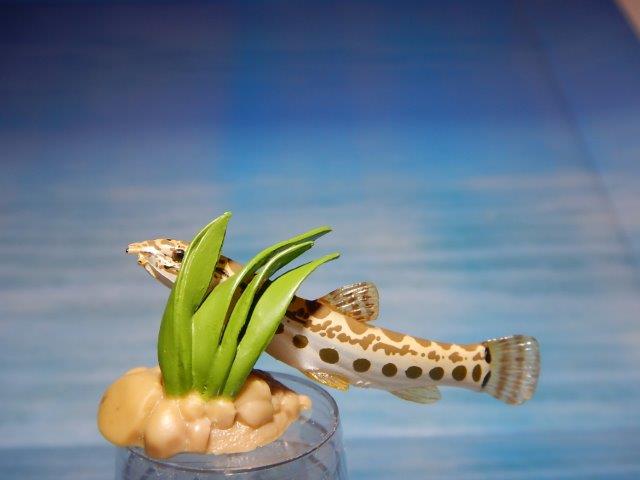
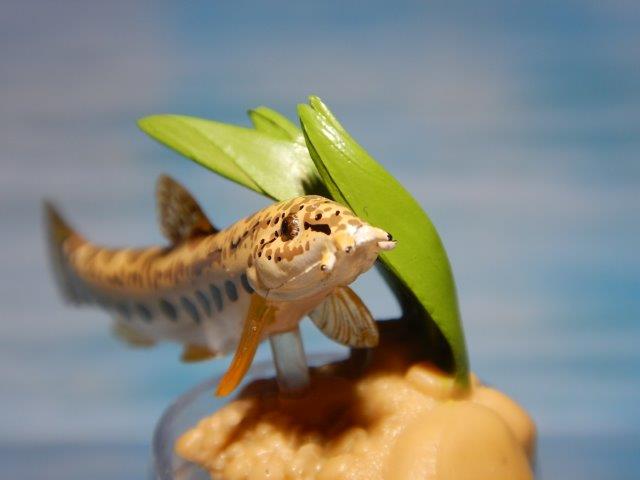
This figure is the Japanese Spined Loach (or Japanese striped loach), Cobitis biwae , model 22, and number 7 from the second series. This is a small, long-bodied loach endemic to Japan, there are numerous potential subspecies but no distinction was made with the model. There are actually a number of similarly-patterned loach species in many parts of Japan, but so far this is the only species specifically identified on figures. This particular species is native to the island of Honshu, but is considered invasive in other areas.
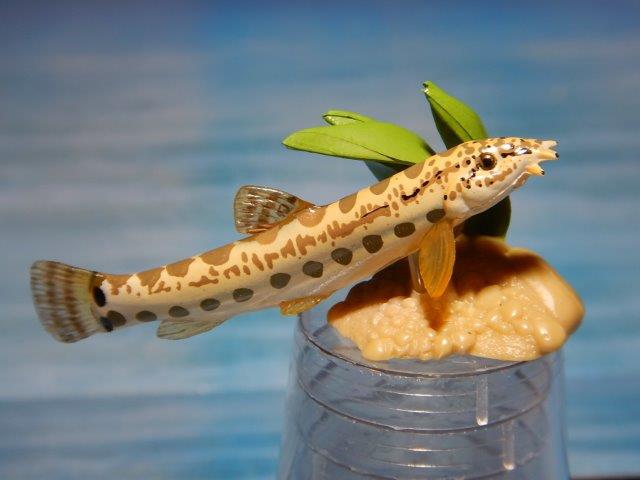
Japanese spined loaches prefer river environments, living primarily along the gravel bottoms. They are predators in the substrate, looking for worms and other invertebrates. The Japanese Spined Loach is exported for keeping in aquaria, and apparently they are also eaten in some places. I remember having ‘dojo loaches’ and the name may come from the Japanese name Shimadojou (although the species was likely related but different). The Yujin model gives a length of 14cm, other sources differed but were close.
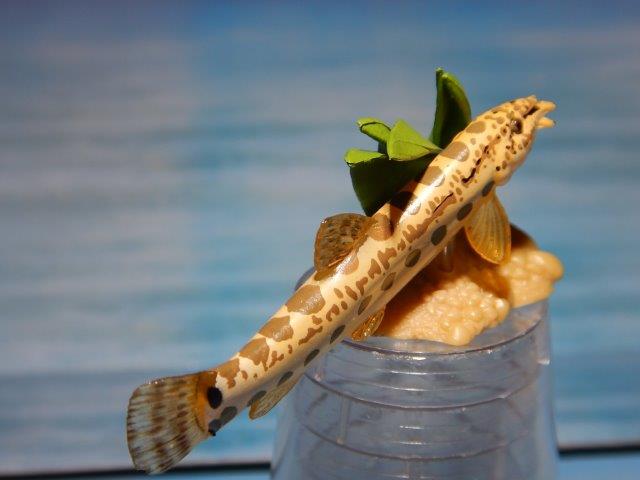
This model is about 5.5cm long, making the figure roughly 1:3 scale. The sculpting of the fish is excellent, capturing even the barbels around the mouth and subtle variations in the mass of the body (the dorsal muscle of the body is wider than the ventral and lateral surfaces) giving the fish a life-like shape. The fins are well defined, with each fin ray clearly present in the yellowish, translucent fins. It is worth noting that this is one of several Yujin models where I do have both versions, so I will be providing comparisons; the differences can be striking.

To describe the second release figure first (because that’s how I got them), the colouring of the figure, in my opinion, tends to be less impressive (EDIT–I was apparently very critical for this one!?). The fish has a pale cream base colour, with three series of separated, brown ochre blotches, one along each side at the midline, and a series of saddles down the dorsal margin in a slightly more muted brown. Between these rows of blotches is a number of irregular dots, dashes and squiggles. Some of the anterior squiggles are highlighted in black. On the base of the caudal fin is a single, darker blotch. In the real fish, these blotches and squiggles exist but are less defined than the solid colouring in the figure, giving it a more cartoonish appearance (when it comes to loaches, they are generally cartoonish enough!). It is also not uncommon for the side markings to be connected but a thin lateral stripe through them.
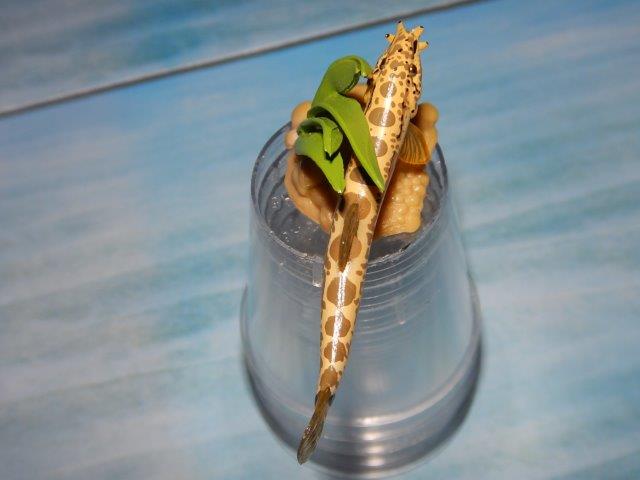
The patterning around the face is very irregular, again where the marking are more distinct than would be present in the real animal. The eye is very well painted, a bright brown base colour with a distinct pupil; at least this is in keeping with the typical, alert look look of most botias and loaches. The base is the brown small gravel, with a plastic plant, which is fitting for a fish that spends a lot of time along the substrate.
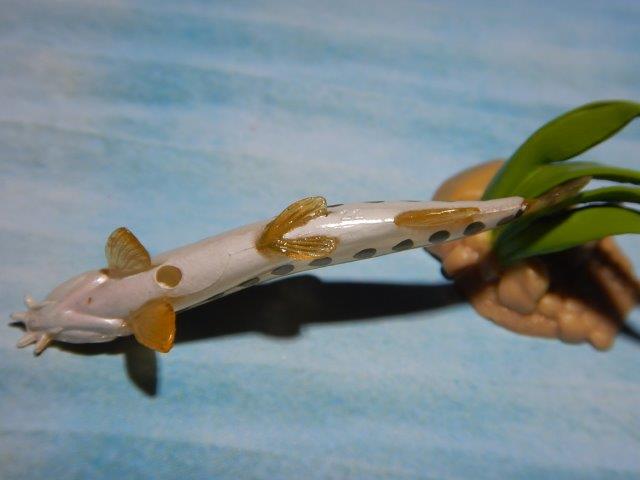
In the First release (R1) spined loach, the most obvious difference is the fewer number of dark blotches than on the Second release (R2)—to the point where there are none along the dorsum of the figure at all, while the R2 has a row of distinct brown patches along the back. The markings are overall much darker as well, closer to a dark umber, and this is the only colour used in the markings. The face of the R1 figure also has simpler markings, mainly simple brown dots, whereas the R2 has a variety of squiggles and dots.

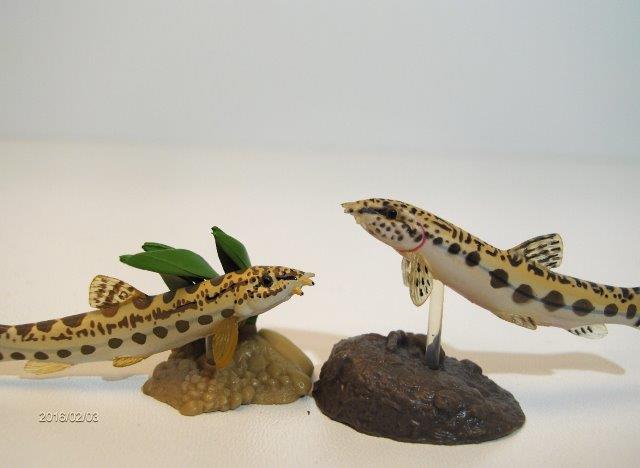
The R1 ventral fins are all marked, while the R2 fins are left unmarked. As well, the caudal fin of the R1 is primarily longitudinal bars, while the R2 has a pair of faint, radiating bands. Finally, the R1 has a more distinctly defined gill by the operculum, marked by a red line. Overall, this will be the expected pattern when comparing Release1 and Release 2; the models are the same, but the overall effort in the paint jobs are markedly different, with far more detail in the R2,
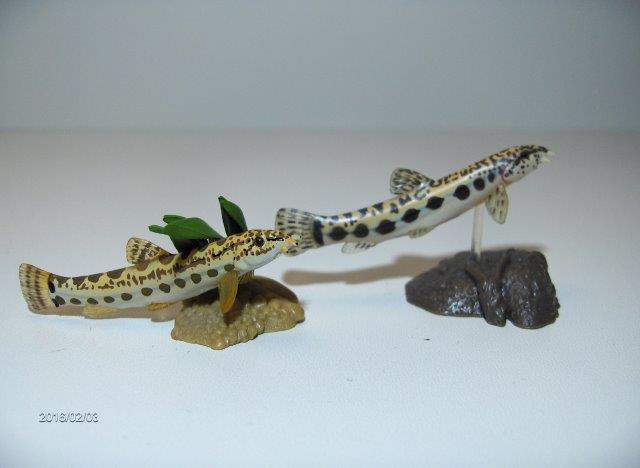
There are definitely other models of this fish made, of course by Japanese companies—I own both a Kaiyodo Animatales and Colorata model (both of which are labelled as C. biwae and so are not other, related species, and there are likely others.
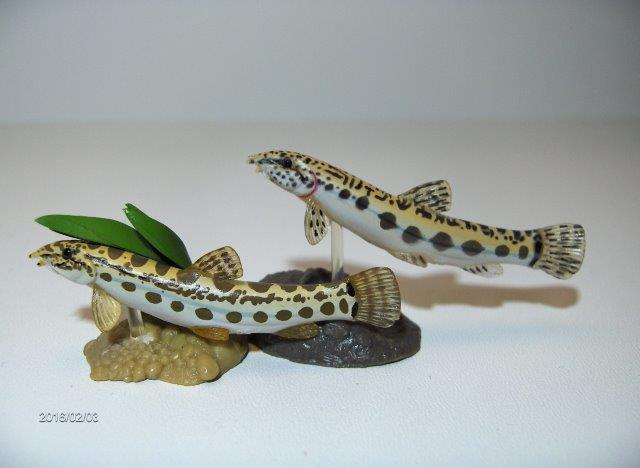
Starting on the 14th of January, 2024, I migrated my first Yujin Freshwater Fish Pictorial walkaround post from the Animal Toy Forum to this blog, with the intention of moving all species’/figures’ walkarounds here. The initial post contained a lengthy explanation of the series (both the original and updated) that I don’t think should be repeated each time! For those details, the post can be seen at the first post. Then we can just get to the fish. Most of the details and writing will come from the original post, although I may supplement/add where appropriate.
From the original Forum post:
- Newt: Thanks for this review! That’s a very nice little figure. I like to see these “ordinary” species represented; the world has enough lion and elephant figures. Plus, I have a warm place in my heart for cypriniforms of all sorts. You mentioned YAJ; is that the best place to order Yujin figures? I’m guessing biwae refers to Biwa, Japan’s largest lake. I visited Biwa on my sole trip to Japan, reaching it near sunset after a long walk among rice paddies teaming with Hyla japonica metamorphs. Unfortunately I saw no loaches, or fish of any sort, at the lake.
- Sbell:That is one of my favorite parts of the series–it isn’t all ‘famous, sport, or food fish. Well, most of them are, but it does also bring in the minnows, the stickleback, the smaller salmonids, etc. We need more of those overall–good for education and collections. The loach is a good example–it was one of my first Yujin fish (after the snakehead). I would say YAJ is definitely the best spot for Yujin, in all series. Talk to Brett. I do know that, if I hadn’t already gotten a bunch many years ago, followed by a few last figures, it’s a good way to get a complete set of the fishes. And if someone is willing, it’s even possible to get a full set including all of the variants (including albino eels, hybrids patterns, multiple fancy koi varieties, etc). Expensive all at once–but complete!
- Advicot: Really like this figure.

Disclaimer: links to Ebay and Amazon on the AnimalToyBlog are affiliate links, so we make a small commission if you use them. Thanks for supporting us!



